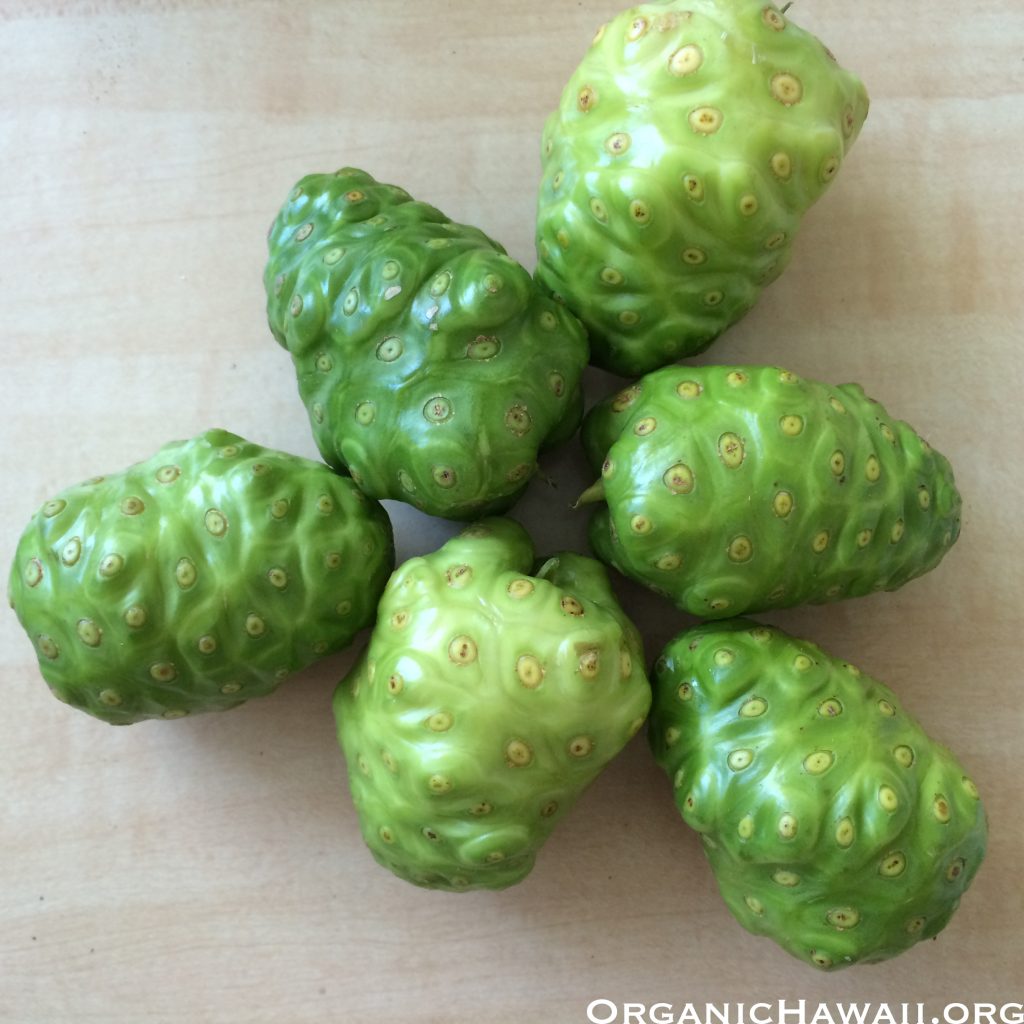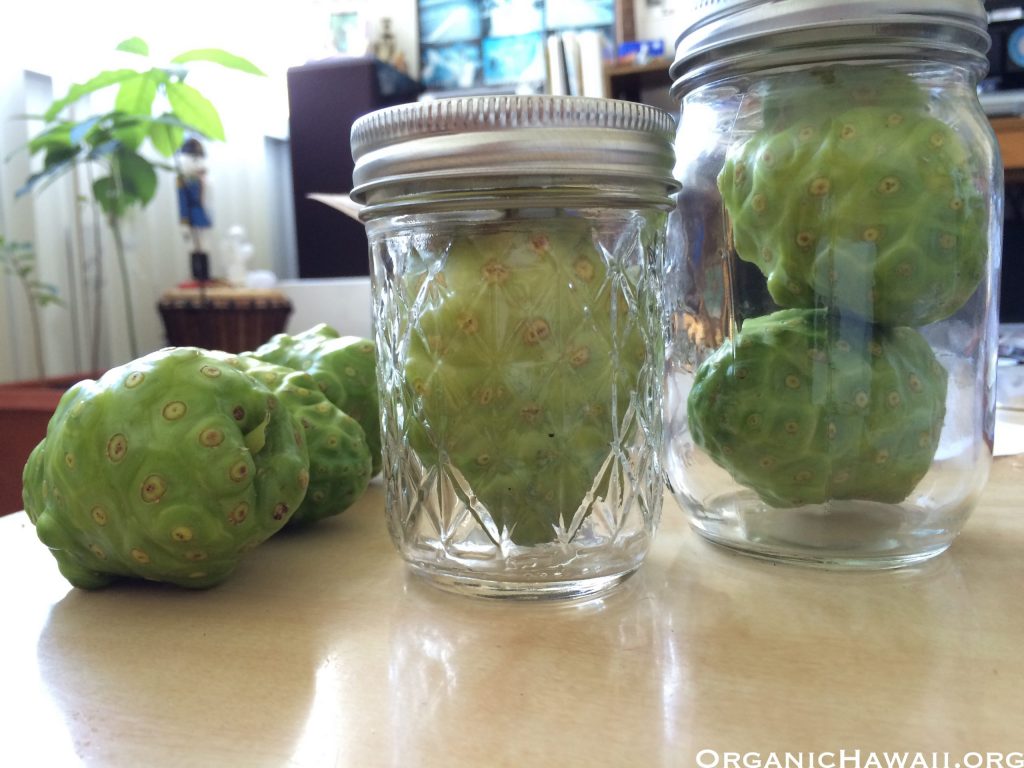How to Make BEST NONI JUICE at Home: Easy Step-by-Step Guide
One of the great things about living in Hawaii (or another place where Noni grows) is that you can make your own raw organic Noni juice! Noni juice is easy to make (and has a pleasant taste) if you do it right. Very healthy for a variety of health issues. A true tonic.
Noni is simply amazing!
Noni also known as Indian mulberry and Morinda citrifolia is an amazing fruiting tree native to India, Malaysia, Indonesia, Philippines, and Polynesia including Hawaii. It can be easily grown in tropical and sub-tropical climate.
Surprisingly, Noni is related to the coffee family of plants. And is known to exhibit a mellow, calm buzz to those who drink the juice. Noni contains no caffeine and a multitude of beneficial compounds and enzymes.
Noni was one of the original canoe plants that ancient Polynesians thought was so important medicinally that they brought it with them across thousands of miles when they settled Hawaii.!
In Hawaiian mythology Maui the demigod was resurrected after being wrapped in Noni leaves!
In fact, ancient Hawaiians treated bruises, cuts, and even broken bones with Noni leaves.
Medical Disclaimer: Having that said, if you do have a medical condition please speak to your doctor regarding any medicinal treatments or drinking raw unpasteurized juices including Noni juice. Affiliate disclaimer: As an Amazon Associate I earn from qualifying purchases. You don’t get charged extra and I make a small commission that supports Organic Hawaii.

Image credit: © P. S. Yushin | BestHawaii.photos
Noni is a SUPERFRUIT SUPERFOOD 😀
We’ve made and drank our own homemade raw organic Noni juice for many years and have never experienced any unpleasant side effects. In fact, we’ve only had beneficial experiences with Noni and that’s why we absolutely love it!
Noni produces fruit all year round and grows in almost any sub tropical or tropical condition. It’s one of the first plants to grow in a new lava field after a volcanic eruption! But it can even grow in brackish water. xxx
Given this amazing adaptability and abundance of harvest is this what makes Noni juice so beneficial to health? Because Noni itself is so strong and adaptable? Or is it the multitude of scientific studies and books that confirm it’s health benefits? Perhaps both.
Noni can be classified as a overall tonic. It works in multiple ways due to it’s multitude of beneficial compounds and enzymes. In Hawaii it’s known to be good especially in older age, but research shows that it’s beneficial regardless of age.
Commercial Noni Juice
Noni juice is widely available in health food stores, but it’s pasteurized even if it’s organic. This means it’s been heated to sterilize it. The heating process deactivates beneficial enzymes. However, we did find this organic raw (unpasteurized) Hawaiian Noni juice here.
Also, commercial Noni juice is usually made using large plastic containers, which could leach plastic and other toxins into the juice. Especially when the plastic is exposed to ultraviolet rays from the sun.
Commercial Noni juice may also contain trace amounts of chemicals used to sanitize plant equipment. This usually happens in all food processing across the board. Lastly, commercial Noni juice is not cheap.
One time I ordered local organic raw unpasteurized commercially made Noni juice from the Big Island. When we open the bottle it to taste it, it tasted terrible – not the way great Noni juice is supposed to taste when made properly.
In conclusion, if you can’t make your own Noni juice, then you can buy it. Even raw! Afterall, having some Noni juice (even if it’s commercially made) is better than having no Noni juice.
The Demonization of Noni by the MSM :O
Lately Noni juice got a false bad rep due to inaccurate portrayals by the main stream media (MSM). Especially popular TV shows which make the unaware viewer believe that Noni juice always tastes terrible. This is simply not true.
When made correctly Noni juice tastes great and makes you feel even better!
Also, apparently the word “Noni” isn’t showing up in Amazon books results! We were very surprised. Is this censorship or a search glitch? Nevertheless, here are some books we were able to find using other methods.




OK, LET’S MAKE NONI JUICE!
The good thing is you can easily make delicious, organic, and raw Noni juice at home using the most basic and affordable tools.
This is a step-by-step guide on how to make great tasting, homemade Noni juice the easy way.
We’ve been making our own homemade Noni juice for many years. And we are happy to share with you our secrets and the absolute best way of making best tasting raw organic Noni juice at the comfort of your home.

Step 1: Gather supplies
You will need:
- At least one large 4 liter clear glass jar with a wide mouth and a lid with rubber gasket. We recommend and use these ones.
- About seven medium size Noni fruits to fill the jar. Important: Noni fruit should not be unripe or overripe. If Noni is completely dark green that means it’s unripe – not good. If Noni is yellow, becoming translucent yellow it means it’s becoming overripe. So ideally Noni fruit should be very light yellow color. If Noni is soft and mushy it means it’s over-ripe, which will make it very hard to clean.
- Optional: fruit and veggie brush to clean Noni. This is recommended since air pollutants can get lodged in the crevices of Noni fruits (and everything exposed to modern air! 🙁 The brush is more affective at removing unwanted chemicals than just washing it with hands.
- Optional: fruit and veggie wash. This is a safe liquid wash which helps dislodge potential pollutants from the Noni, as well as any other produce you may want to wash.
- Optional: water filter. Water filter is a must for any household since all tap water has added chlorine (WWI chemical weapon knowns as mustard gas), may have fluoride (a rat poison), toxic heavy metals, and even “forever chemicals”! We prefer reverse osmosis water for drinking, but in our kitchen we use this 9-stage water filter which we recommend for basic meal prep, rinsing, and even brushing teeth.
- Optional; small glass jars or bottles to bottle your newly made Noni juice. We try to reuse our glass containers from previous purchases, but if that’s not available this is a good option.

Step 2: Jar up the Noni!
First, clean Noni fruit by washing it and preferably rinsing it with filtered water.
Put the washed Noni fruit into a large 4 liter glass jar. Make sure the jar’s been washed well and preferably rinsed inside with filtered water. They don’t need to be dried. Filtered water reduces nasty contaminants of tap water and greatly reduces chlorine, as well as it’s nasty smell.
Fill up the jar with Noni fruit all the way to the top and close the lid. Make sure it’s tightly sealed with a rubber gasket and a latch.
Put the Noni jar in direct sun. If direct sun is not available, then partial sun is OK. If partial sun is not available, then you can keep it indoors, however the process will take longer and it will not taste as good as if it was exposed to the Sun.
It’s up to you how long you want to age the Noni. We prefer the more aging, so at least a month. We’ve held Noni jars for over a year and the juice was great!
Step 3: Collect your Noni Juice!
When you notice that enough Noni juice has been deposited at the bottom of your large jar you can open it up. Carefully pour the juice into a separate glass container such as a small jar or a glass bottle. If pouring into a bottle we recommend you use a funnel.
Hold the large jar with one hand while holding the lid slightly open with the other hand. This way the fruit stays inside, while the juice pours out. Don’t touch anything on the inside of the large jar to prevent contamination.
After you’re done pouring the juice close the large jar and put it back, so that more juice can be extracted. You can also add more Noni fruit to it at this point. Eventually the volume of original Noni fruit inside the jar will shrink, making room for new fruit. Just make sure you always have clean hands and utensils to prevent any possible contamination inside the jar.
Close the smaller jars or bottles (with freshly collected juice) and put them in the fridge for long-term storage. But don’t wait too long – enjoy the goodness and share it with your family and friends!
CAUTION: By the way, even though Noni is naturally resistant to bacteria and certain pathogens, if you see weird mold or weird stuff growing inside your jars you will need to dispose of it, clean and sanitize everything and start over.
I Want it NOW!!
Ok, you can buy it! Or if you’re a little patient you can drink your homemade Noni juice sooner.
The reality is Noni juice is drinkable as soon as the liquid starts to seep out of the fruits. It will be clear yellow color in the beginning. The taste won’t be as complex as aged Noni, but if you’re pressed for time, you don’t have to wait a month or longer. It can be a week or so.
As a matter fact, Noni fruit is listed in the army survival manual TM 10-420 Emergency Food Plants & Poisonous Plants of the Islands of the Pacific as one of the edible fruits in times of crisis! Yes, it’s not great tasting but in times of food scarcity taste becomes less relevant.
Having that said you can bite into Noni fruit when it’s soft and ripe, but there are seeds, texture, and taste issues you may not like.
Therefore, drinking properly made homemade raw Noni juice is a beautiful solution to this.
Patience is a virtue 🙂
The longer you hold Noni in the jar – the more juice will come out of it. It will start to turn into a beautiful golden color, then a beautiful bronze after lengthy aging under the Sun.
So it’s up to you when you want to collect the Noni juice. You can even taste it at different stages of the process to see which one stage you prefer.
We’ve tried all sorts of different Noni juices. Personally we prefer the really aged dark bronze colored Noni juice.
The ideal Noni juice taste can be described as a complex taste of pineapple, toasted coconut, semi-sweet with a pinch of tartness, grounding, yet uplifting. Balancing, calming, and meditative. It could easily be described as an acquired taste, that gets better with time, the more you drink it. Great Noni juice flavor is surely appreciated by those who appreciate best things nature has to offer.
We hope you enjoy your own homemade organic Noni juice and share it with your family and friends!